Ijraset Journal For Research in Applied Science and Engineering Technology
- Home / Ijraset
- On This Page
- Abstract
- Introduction
- Conclusion
- References
- Copyright
IOT Based Driver Drowsiness Detection and Smart Alerting System
Authors: Akshara M. C., Harshitha T. S., Nithya Deepak, Priyanka B, Prof. Sharath H. A.
DOI Link: https://doi.org/10.22214/ijraset.2022.45810
Certificate: View Certificate
Abstract
Generally, road accidents caused by a fatigue driver is a very serious problem causing in thousands of road accidents each year. According to the National Highway Traffic Safety Administration, every year about 1,00,000 police reported crashes involve drowsy driving. Drowsiness is one of the main causes of accidents alongside with other cases such as drunk driving, distractions, and so on. A way to overcome this issue would be with the use of sensors. They can detect, alert and can potentially save a person’s life. For drowsiness detection, there are certain bio-indicators that can detect the driver’s face for any signs of drowsiness and can alert them before anything harmful could happen. The buzzer will be activated if the driver’s eye-blink and the health parameters are found abnormal.
Introduction
I. INTRODUCTION
Countless of mishaps regarding road accidents are caused by fatigue, tiredness, and so on. About 50% of the accidents are road accidents. The road accidents can be due to inadequate way of driving, and these could arise if the driver is an alcoholic or drowsy. The drowsiness and the alcoholic condition of the driver has become a major cause for the road accidents. This also has led to major challenges in developing a system for the prevention of this issue. IOT-based innovation tends to be much more practical to work with since it runs on a real time system, and it can transfer all the data or information without any human interaction.
Fatigue is a safety problem that has not yet been deeply tackled by any country in the world mainly because of its nature. Drowsiness, in general, is very difficult to measure or observe unlike alcohol and drugs, which have clear key indicators and tests that are available easily. An IOT –based system is designed to avoid countless mishaps due to drowsy drivers’ behavioural and psychological changes by focusing on driver’s eye moments and health issues like heart attack, dizziness, and other health issues.
We’ll be focusing on the drowsiness aspect of it followed by checking other health parameters like pulse and alcohol detection. To obtain a solution to drowsy driving is extremely new and is set in motion. But the steps to prevent it with the help of IOT sensors and methodologies is what this paper discusses on IOT-based innovation will offer propelled dimensions of administrations and for all intents and purposes change the way individuals lead their day by day lives. Fatigue is a safety problem that has not yet been deeply tackled by any country in the world mainly because of its nature. Drowsiness, in general, is very difficult to measure or observe unlike alcohol and drugs, which have clear key indicators and tests that are available easily. An IOT –based system is designed to avoid countless mishaps due to drowsy drivers’ behavioural and psychological changes by focusing on driver’s eye moments and health issues like heart attack, dizziness, and other health issues. The main aim of this project is to develop a certain system which is efficient to predict the drowsiness and the health parameters of the driver using sensors to alert the driver and reduce the increasing number of accidents. The following are the problems we are going to tackle in our entire project:
- Driver Drowsiness Detection
- Alcohol Detection
- Vehicle Locking System
- Pulse Rate Monitoring System
- Crash collision Detection
The basic purpose of this system is to track the driver’s facial condition and eye movements if the driver is feeling drowsy, then the system will trigger a warning message. When the drowsiness is detected, the driver is alerted by a buzzer. Measurement of different parameters of the driver such as Pulse Rate, Alcoholic Condition and Eye blink using the sensors like Heartbeat Sensor, Alcohol Sensor and Eye Blink Sensor respectively. There are many products out there that provide the measure of fatigue level in the drivers which are implemented in many vehicles. The driver drowsiness detection and health monitoring system provide the similar functionality but with better results and additional benefits. Also, it alerts the user on reaching a certain saturation point of the drowsiness measure.
II. LITERATURE SURVEY
- This paper introduces driver drowsiness & health parameters detection system using IoT. This system provides USB camera for Eye-Blink Monitoring System and includes a Buzzer to alert the driver when he is drowsy. They have also included a GPS to track driver's location. Here admin will be monitoring the system parameters and send a message to friends/relatives in case of emergency. Driver's health is monitored by wearable Heartbeat sensor and Temperature Sensor. Alcohol Sensor is used to detect alcoholic condition of driver when alcohol level crosses threshold value, the vehicle speed goes down and vehicle stops [Speed Limiter is provided]. The goal of this project is to develop cost effective system that can be implemented in all range of cars & save people. Drowsiness in detected via a USB camera and data is processed using python built in library. If driver is drowsy an alert is generated via buzzer. Also, health parameters that is heartbeat and body temperature of driver is monitored continuously by the system. In case of emergency, a doctor or driver's friends can reach him by knowing his location via GPS. As a result, accident ratio can be reduced.
- In this paper they have done comparison between eye State analysis-based approaches & proposed system & distraction detection techniques. where they found that Eye state analysis is better compared to other methods (non-intrusive, low computational cost, robust, accuracy). The proposed System uses a pair of wearable smart glasses as main medium to detect drowsiness. Sleep detection theory 0-2 to 0-4 sec to blink (normally) If eyes close for more than 30 sec, an individual is considered asleep. Proposed miniature bandpass CR light sensor this is implemented for low cost, lightweight wearable Smart glasses which can provide a brighter Signal-to-noise Ratio (SNR) than commercial one. DFD Recognition Records shape of eyeball, nose, & pupil. Status of eyes (closed/open) is detected. If closed, drowsiness found then DFD sends warning menage to IVI telematics platform via BLE.
- They have used AI-based advanced algorithms to detect driver fatigue and the rate at which driver is drowsy. In India, there were 4,64,674 accidents in 2015. The major reason for these accidents is either the driver does not follow the traffic rules, or he is drowsy. India has a higher road accident rate compared to the USA. There are many features to consider for detecting drivers’ fatigue and some of them which has used till now are lane detection, heart rate, steering wheel movement pattern detection. If the person closes his/her eyes for 5 sec then he is considered as drowsy but, we need more time to decide drowsiness of a person and the rate at which the person is drowsy is also not considered. They have converted video into frames using the open cv library of python. They have used Eye aspect Ratio (EAR) for identifying the frames in which the subject is drowsy. It is calculated by adding the two distances from the top end to the bottom end of the eye, which is then divided into by horizontal distance. of the eye. They have used decision tree classifier and neural network classifier. They stated that the DT classifier is better than all other classifiers for that project, but the neural network classifier has given almost equal results. So, we can use any of the two classifiers for classifying the subject to be drowsy or non-drowsy.
- An IOT based Drowsiness detection and emergency notification system is a safety technology which helps to put off accidents that causes due to driver drowsiness. A variety of studies have recommended that around 20% of all road accidents are due to drowsiness of the driver. In the first part, alcohol sensor is used to measure the content of alcohol in driver's breathe, if alcohol level is more than the threshold value, then driver is regarded as alcoholic, buzzer will be on, "alcohol detected" message will be displayed on the lcd and vehicle will not start. In the next part, driver has to wear any sunglass fixed with eye-blink sensor throughout his journey, which is used to detect drowsiness. If the driver doesn't blink his eyes for couple of seconds, then drowsiness will be detected, buzzer will be on, "drowsiness detected" message will be displayed on the lcd and the motor speed will be reduced. In the last part, after the alert system the notification system is used, if the driver detected with excess alcohol and drowsiness, then message along with the location details will be sent to the telegram application, so that the person can use this information to save the driver, who is in danger. For vehicle accidents various factors involved such as drunk driving, over speeding, many distractions like texting while driving, talking with others, playing with children etc. one of the important factors is sleeping on the wheel. Many drivers cannot control the vehicles due to different it may cause severe accidents and sometime death. A fatigue Driver those who falls asleep at the move fails to control the vehicle, not possible to take immediate action and results in a crash so it is necessary to monitor the drowsiness of the driver to prevent accidents.
- This paper proposes a google-glass based drowsiness detection System. & Proximity sensor was attached to the glass to monitor eye blink frequency. Driving. This was tested among 23 experienced drivers, 13 females & 10 males. It happened from 8 am - 8pm. found that threshold algorithm for proximity sensor can reliably detect eye blinks and proved the feasibility of using google glass to detect operator drowsiness and may put drowsy drivers at higher risks compared to distracted drivers.
III. REQUIREMENTS
A. Hardware Components
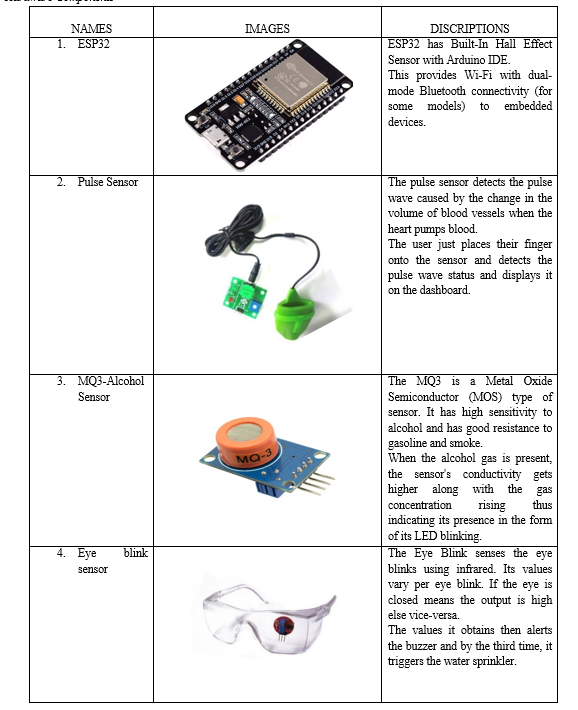
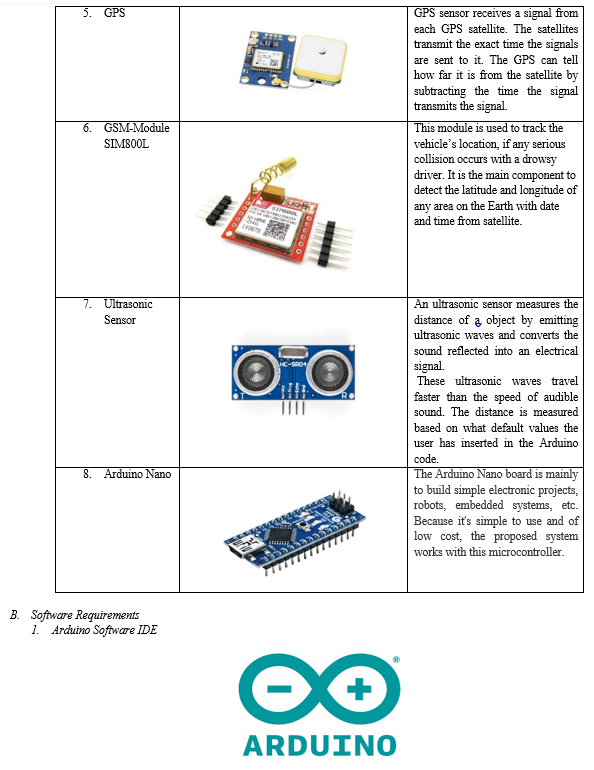
The Arduino integrated development environment (IDE) is a cross-platform application (written for Operating systems like Microsoft Windows, macOS, and Linux) which is written in the Java. It includes a code editor with features like text cutting and pasting, searching, and replacing text, automatic indenting, brace matching, and syntax highlighting, and more. Message area, a text console, a toolbar with buttons for common functions and a hierarchy of operation menus are also included in Arduino IDE.
The Arduino IDE supports the languages C and C++ to work with different sensors and applications. There are different libraries which Arduino supports depending on the user’s choice, they can install and run it without the needs to re-install any of the main application.
2. Thinger.io Console

Thinger.io is a cloud IoT Platform that provides every needed tool to prototype, scale and manage connected products in a very simple way.
a. Free IoT platform: Thinger.io provides a freemium account with only few limitations in terms of the number of sensors that can be connected, however if the user wishes to work with a greater number of sensors, they can choose the premium licensed version which has many more options to choose from compared to the free version.
b. Simple but Powerful: All in the matter of working with components in the platform is so much easier to connect to obtain the values and just in few minutes and is powerful and quick to run the application.
c. Hardware agnostic: Any device from any manufacturer can be easily integrated with Thinger.io's infrastructure.
d. Extremely scalable & efficient infrastructure: The IoT server subscribes device resources to retrieve data only when it is necessary, a single Thinger.io instance can manage thousands of IoT devices with low computational load, bandwidth, and latencies.
e. Open-Source: It can be made available to the public to view, and it is also extremely easy to import/export from GitHub for ready-made codes.
IV. PROPOSED SYSTEM
Our proposed system consists of two microcontrollers: Arduino Nano and ESP32 where the ignition key, Ignition relay, buzzer, Eye-blink sensor, pulse sensor, ultrasonic sensor and alcohol sensor are connected to the Arduino Nano board. The GPS, GSM and the water sprinkler are connected to the ESP32 board. All the values from these sensors are being sent to the cloud server. The reason why we are using two microcontrollers is that the Arduino Nano does not have internet connectivity hence the usage of the ESP32.
The thinger.io displays:
- The pulse values
- Alcohol indication
- Ignition key ON/OFF
- Map location
- Drowsiness indication
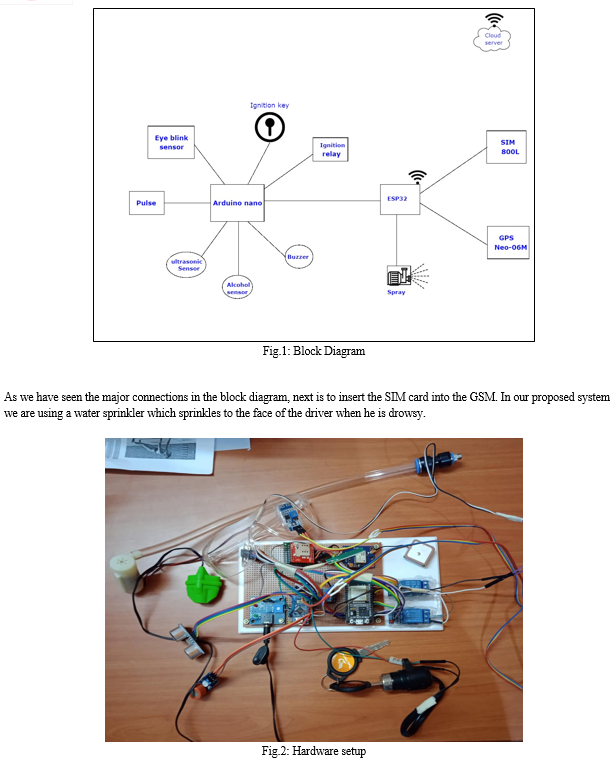
- Hotspot: The first step is to turn ON the hotspot to run our proposed system.
- Adaptor: The next step is to turn ON the adaptor so that all the components get turned ON.
- Pulse sensor: The driver must wear the pulse sensor to measure his heartbeat which tackles one of the health parameters.
- Goggles: The driver must wear the goggles to detect the drowsiness.
- Buzzer: If both drowsiness and obstacle is detected, the buzzer turns ON.
- Water sprinkler: If the drowsiness is detected for the third time, the water gets sprinkled on the face of the driver.
- Ignition key: The ignition key turns OFF once the Water sprinkler is activated and when the alcohol is detected.
- Cloud: It displays the value of pulse; alcohol is indicated as green If the driver hasn't drunk and is indicated as red when the driver is in alcoholic condition. Then we have ignition key value which displays as ON/OFF. The location of the driver can be viewed on the map and drowsiness displays YES if the driver is drowsy and NO vice-versa.
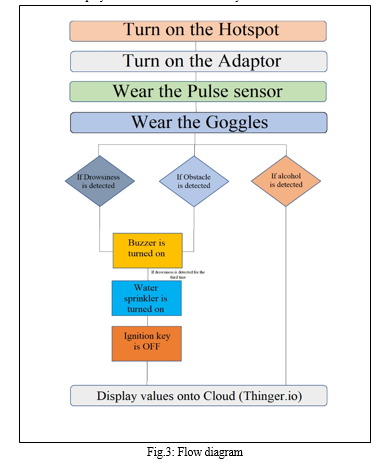
In our proposed system, the driver must wear the goggles and the pulse sensor to detect the drowsiness and the health parameter. Once the ignition key gets turned ON all the components gets activated and the heartbeat of the driver is measured through pulse sensor and is displayed in the cloud. If the driver eyes is closed for more than 4 seconds the eye blink sensor attached to the goggles will detect and buzzer alerts the driver, similarly if the driver eyes is closed for 3 times along with the buzzer the water get sprinkled on the face of the driver, the ignition key gets turned OFF automatically, in cloud the value gets updated and a message is send to the family members along with the location of driver. The MQ3 sensor in our proposed system detects the alcoholic condition of the driver and it will also be indicated in the cloud as well as a message will be sent to the family member along with the location of driver. Ultrasonic sensor in our proposed system detects objects whenever the driver is drowsy, alcoholic or is unwell due to health parameter and alerts the driver through the buzzer which helps to reduce accidents.
V. RESULTS
Our project has a capability of detecting the drowsiness, alcohol, pulse rate and obstacle detection to reduce accidents. If the alcohol and drowsiness is detected the ignition key is turned off and the SMS will be sent to the respective family member and the location of the driver as shown in Fig 4. Having that feature allows the driver’s family or relatives to locate the driver quickly if gotten to any accidents.
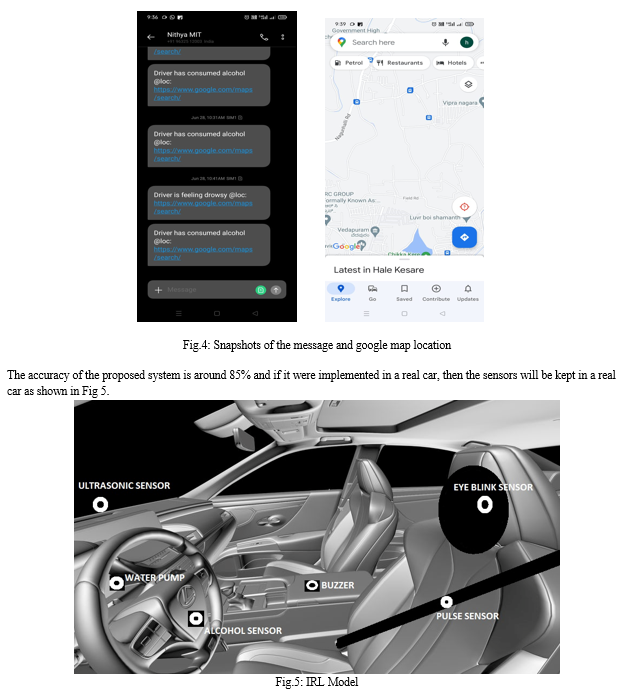
Conclusion
Drowsy driving is one of the main causes of road traffic accidents around the world of around 21% and counting. By contrast, around 28% of accidents are caused by drunk driving and is increasing rapidly. According to the study of all the research papers at hand, each paper had a different approach with detecting driver drowsiness but followed similar practices in reducing/preventing it. From the comparations between other drowsy detection techniques, we have found that the eye state analysis-based techniques are the better methodology for detecting drowsiness/fatigue. Eye-state analysis- based methods has many benefits such as being non-intrusive and having low computation costs, high robustness, high accuracy and so on. Some of the research papers also measures certain parameters like pulse rate, temperature, alcohol consumption and based on that the vehicle stops/reduces its speed. Based on these findings, our goal is to implement a system that ensures the safety of the driver and avert vehicle accidents.
References
[1] “IOT Based Driver Drowsiness and Health Monitoring System” by Ashwini, Veda M, Smitha S, DivyaKrishna, Pooja Suresh Talekar an IRJET paper – 2020 [2] “Design and Implementation of a Drowsiness-Fatigue-Detection System Based on Wearable Smart Glasses to increase Road Safety” by Wan-Jung Chang, Liang-Bi Chen and Yu-Zung Chiou an IEEE paper - 2018. [3] “Driver’s Drowsiness Detection” by Challa Yashwanth and Jyothi Singh Kirar an IEEE paper - 2019. [4] “Drowsiness Detection and Emergency Notification System” by Jagadish N, S Sujay Kumar, Sumanth H S an IRJET paper - 2021. [5] “Detection of Driver Drowsiness using wearable Devices: A Feasibility Study of the Proximity Sensor” by Jibo He, William Choi, Yan Yang, Junsi Lu, Xiaohui Wu, Kaiping Peng an ELSEVIER paper - 2017. [6] “A Smart Drowsiness Detection System for Accident Prevention” by Akhil Kondapaneni, C Hemanth, R G Sangeetha a SPRINGER paper - 2020. [7] “Challenges of Driver Drowsiness Prediction: The remaining steps of implementation” by Emma Perkin, Chiranjibi Sitaula, Faezeh Marzbanrad an IEEE paper - 2021. [8] “Smart driver assistance system using raspberry pi and sensor networks” by V. Sanjay Kumar, Ashwin Balaji , E. Prabhu an ELSEVIER paper - 2020. [9] “Automatic Driver Drowsiness Alert and Health Monitoring System using GSM” by Bhavana T. Petkar, Bhagya C, Gagan T K, Lokesha K an IJERT paper - 2018. [10] “IoT Based Driver Drowsiness and Health Monitoring System” by Dr.K.S.Tiwari, Supriya Bhagat, Nikita Patil, Priya Nagare an IJRAR paper - 2019. [11] “Real-Time Driver-Drowsiness Detection System Using Facial Features” by Ruoxue Wu an IEEE paper - 2016. [12] “Driver Drowsiness Detection” by V B Navya Kiran, Raksha R, Anisoor Rahman, Varsha K N, Dr. Nagamani N P an IJERT paper - 2020. [13] “Accident prevention and safety assistance using IOT and machine learning” by S.Uma, R. Eswari a SPRINGER paper - 2021.
Copyright
Copyright © 2022 Akshara M. C., Harshitha T. S., Nithya Deepak, Priyanka B, Prof. Sharath H. A.. This is an open access article distributed under the Creative Commons Attribution License, which permits unrestricted use, distribution, and reproduction in any medium, provided the original work is properly cited.

Download Paper
Paper Id : IJRASET45810
Publish Date : 2022-07-20
ISSN : 2321-9653
Publisher Name : IJRASET
DOI Link : Click Here
 Submit Paper Online
Submit Paper Online

